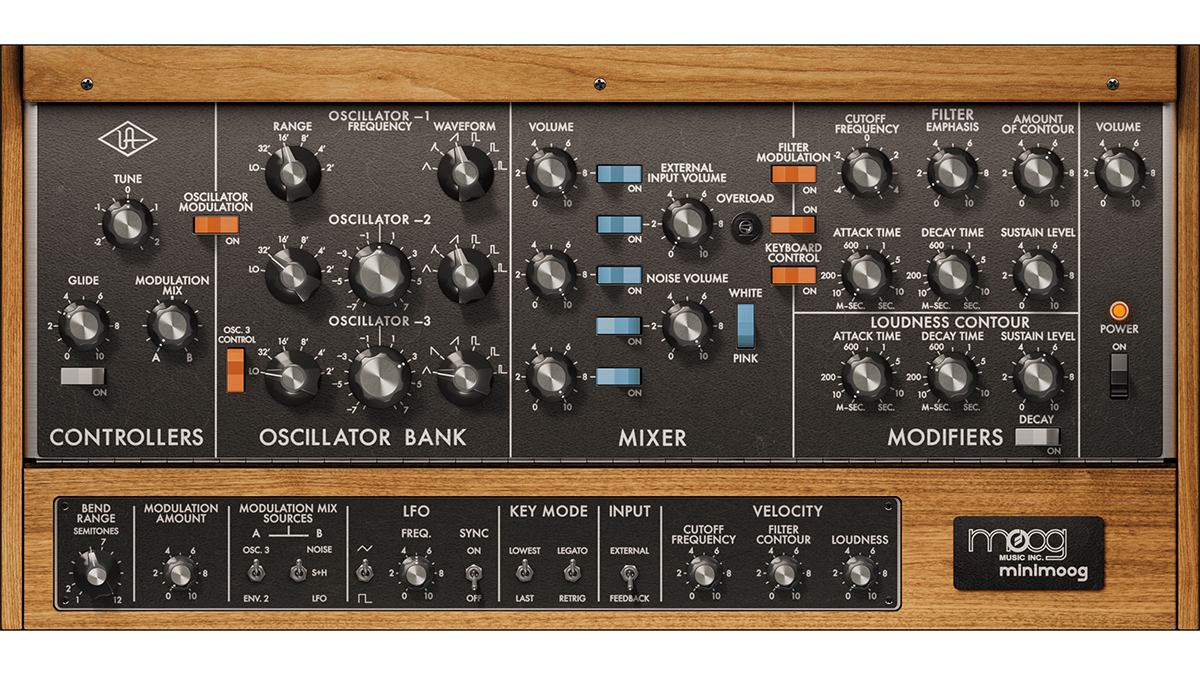MusicRadar Verdict
This is Moog and far more, thanks to its substantial subtractive hierarchy and modulation options.
Pros
- +
Provides a huge Moog sound.
- +
It’s very comprehensive, especially in modulation and filtering.
- +
The output page perfectly sums the signal together.
- +
The iOS version is a total bargain at £30!
Cons
- -
Moving layers can be a faff.
- -
Audio output cannot be set globally.
- -
The GUI is not resizeable.
MusicRadar's got your back
Moog Mariana: What is it?
macOS: 11.7, Intel Core i7 2.5GHz or Apple Silicon or newer
Windows: 10 64-bit, Intel Core i7 2.5GHz systems or newer
Formats: VST3, AudioUnits, AAX
Buy at Plugin Boutique
Whether you know it or not, it’s a pretty safe bet to assume that you’ll have heard a Moog synth playing a bass sound somewhere on a recording at some stage in your listening life. From modulars to Sub Phatty, via the Minimoog and the legendary Taurus bass pedals, it’s clear Moog has synth-bass form.
Moog’s latest release stays in the software domain, while also encouraging us to stay in a bass register. Mariana is capable of providing that legendary Moog sound at a sensible price, but we’re intrigued to know how it differs from its previous softsynth outings.

Moog Mariana: Performance and verdict
At first sight, the control panel is unmistakably Moog; the pots glisten, appearing three dimensional on a flat screen. It’s also uncluttered, which is largely because the synth’s panel is laid out across five pages. These pages break down sensibly, forming two synth layers.

• Universal Audio Moog Minimoog
UA’s licensed Minimoog will provide a classic Mini sound, which is perfect for basses.
• Cherry Audio Lowdown
Based on the legendary Taurus pedal-synth, this extends to the lowest of depths.
We’ll begin with the layer called Synth 1; our sound starts with a dual oscillator, through five traditional subtractive waveforms. Once you select a waveform, this is shared across both elements of the dual oscillator, with independent tuning control for each. Oscillator 2 can be set at the same pitch, or one/two octaves above, but with hard tuning up to a perfect 5th above or below your triggered note, you can pretty much set the oscillator pitch wherever you want. The shared nature of the waveform might feel restricting, but the Duty Cycle control provides a form of pulse width modulation, across all chosen wave types.
It doesn’t end there though, because a further sub oscillator is also onboard, switchable in octave range only, but offering a sine, saw or square wave, along with a phase pot, to alleviate phase cancellation issues.
All of these source components are blended at the Synth 1 layer level, using the mixer, which also provides a level pot for noise. This occurs before moving on to the incredibly comprehensive filter section, which is comprised of three independent sections; low-pass, high-pass and sub filter. All three have resonance and envelope modulation control, while the sub filter is switchable between high, low and band-pass modes. Unsurprisingly, the filters sound exceptionally good, with true Moog colour. The band-pass is a particular favourite, with its wispy quality, which is ideal for those classic reduced band-width bass parts.
Unsurprisingly, the filters sound exceptionally good, with true Moog colour
Alongside the Synth 1 layer, the Control 1 Layer has plenty of modulation sources, which include three individual LFOs, each syncable and with a phase control, and three envelopes. Two of these ADSR envelopes are hooked directly to the amplifier and filter sections, while the third envelope offers five stages, with an additional delay trigger. You’ll also find two random generators, with sync and slew.
Want all the hottest music and gear news, reviews, deals, features and more, direct to your inbox? Sign up here.
This compendium is pretty complete, but as Mariana offers a second Synth and Control layer, you do have to double the capacity for sonic creation, with two of everything. This means that there’s a ton of tonal options for a monophonic synth (which can also be switched to a duophonic mode) but also that there are several layers to compete with when editing.

Modulation and more
The undeniable Moog sound presented by Mariana is pretty exceptional, but providing a fixed timbre is only half the story. Alongside the traditional modulation control, within each control layer, there are a host of other options. The Modulation page opens to reveal assignable sources from all over the synth, with full detailing at each level, as a pop-up window gives access to the modulation settings for each source and destination. It’s beautifully engineered onscreen, and a useful method for controlling elements such as the filter cutoff controls, from a single source such as the modulation wheel.
Meanwhile, MIDI CC Mapping can also be applied as required. One of the more exciting prospects is its ability to apply virtual CV (control voltage) connections. If you have any of the Moogerfooger software effects pedals, you can instantly engage this element, as the Moogerfoogers can trigger elements such as LFO or envelopes, and vice versa.
Verdict
The final page which ties everything together is the Output page. The central Summing mixer blends the signals, applying compression and effects too, with the effects added at the synth layer level.
Finish all of this off with an Animoog-style keyboard and you have the most fantastic-sounding Moog package, which can provide a ton of synth bass detail, and a lot of other synth lines too, if you play that little bit higher.
MusicRadar verdict: This is Moog and far more, thanks to its substantial subtractive hierarchy and modulation options.
Moog Mariana: The web says
"Mariana might not be exactly what you expect from Moog… There are plenty of authentic sounding Minimoog emulations already out there, so it’s nice that Moog has built a synth with that desirable Moog flavour with a slightly different, contemporary sound."
MusicTech
Moog Mariana: Hands-on demos
Moog Music Inc
Molten Music Technology
Starsky Carr
Plugin Boutique
Moog Mariana: Specifications
- macOS 11.7 Intel Core i7 2.5GHz or Apple Silicon or newer, standalone and plugin formats VST3, AudioUnits, and Pro Tools AAX.
- Windows 10 64-bit Intel Core i7 2.5GHz systems or newer, standalone and plugin formats VST3, and Pro Tools AAX.
- CONTACT: Moog
Roland Schmidt is a professional programmer, sound designer and producer, who has worked in collaboration with a number of successful production teams over the last 25 years. He can also be found delivering regular and key-note lectures on the use of hardware/software synthesisers and production, at various higher educational institutions throughout the UK





